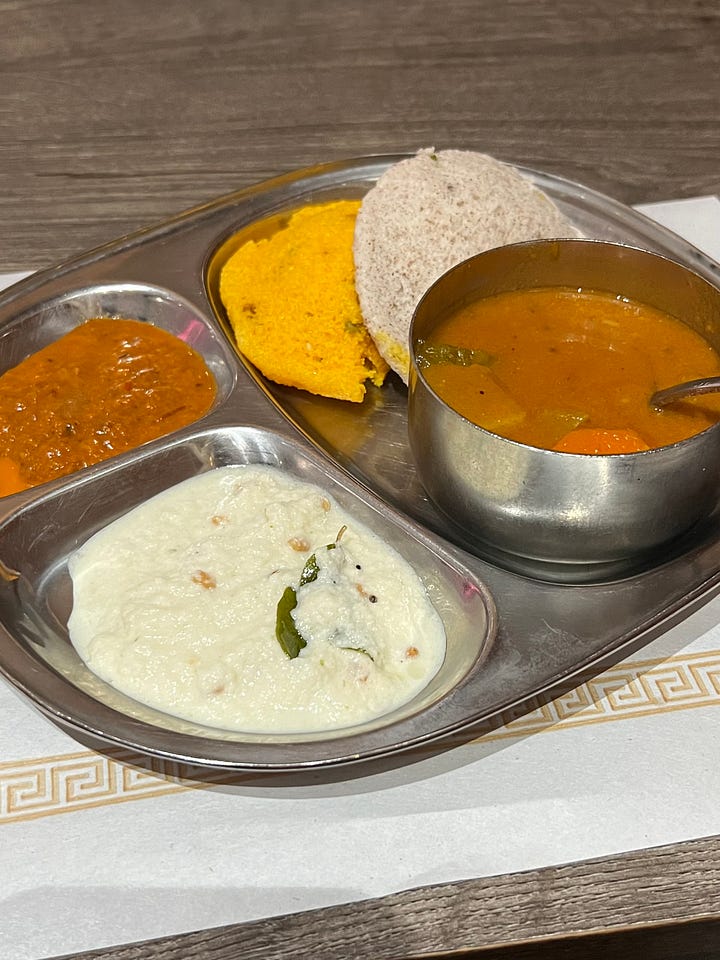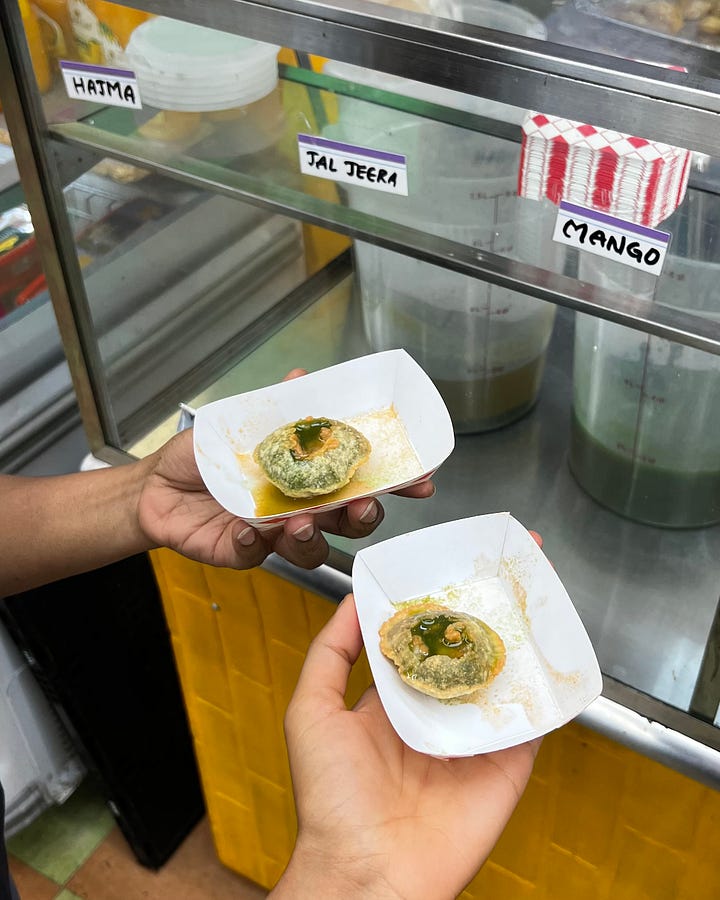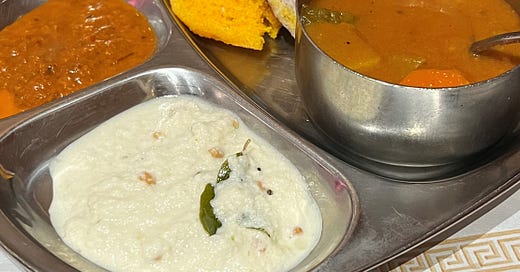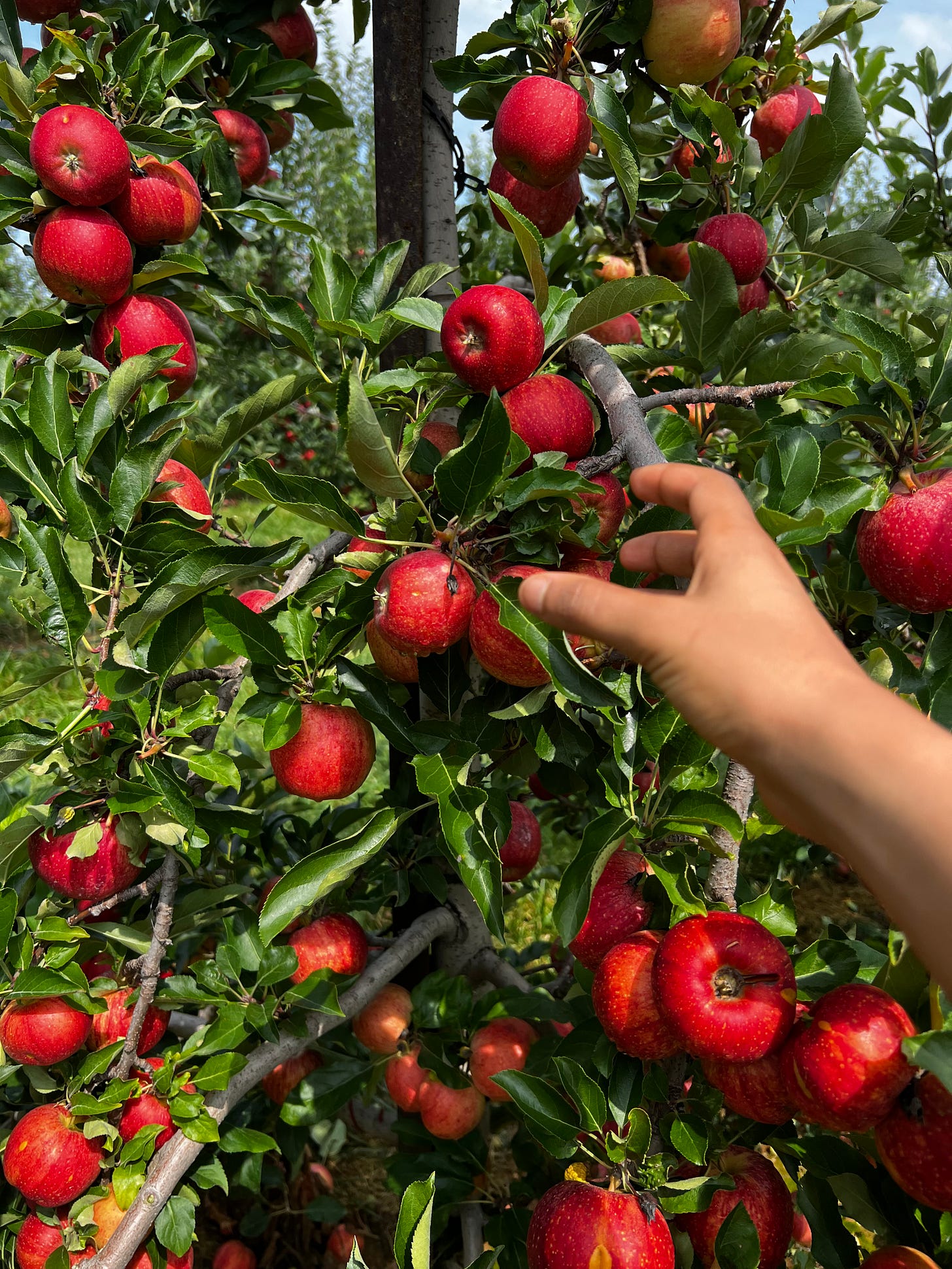The problematic undertones of vegetarianism in India
diet, caste, and purity politics (Indian foodways, part one)
In elementary school, several of my friends were vegetarian because their families were vegetarian. They seemed to be indifferent about abstaining from tandoori chicken during summer BBQ season, which baffled me, a 10-year-old who was smug when eating meat, much like some influencers are when they post themselves eating ice cream with a caption like “POV: you found food freedom” (usually preceded by an unsolicited body check, but we won’t get into that).
Eating everything felt like rebellion against an ideology I didn’t resonate with—that my family or religion limited what I ate, which isn’t entirely different from how people in certain liberal circles justify their choices. Given the relationship between caste and vegetarianism in India, some people eat meat to express their disdain for casteism, affirming that they are a true liberal.¹ Although this is a form of symbolic action, challenging caste-based rules for consumption and exclusion is going to take much more than eating beef, a truth that has been acknowledged by people who want to see changes in the Indian food system.²
I was too young to explain my tendencies with these terms and my family wasn’t even vegetarian, so I wasn’t really rebelling. Still, I was a timid and nervous child, so being an adventurous eater invoked the same vicarious thrill as listening to angsty pop rock bands on my headphones in middle school; I would never consider sneaking out of the house, but I would headbang and imagine my escape plan. Likewise, through eating foods that made my mom squirm, I channeled a hidden reserve of fearlessness that otherwise withered when doing everyday kid things, like raising my hand for participation points. (Though to be fair, that must be every introverted child’s most daunting task.)
Then when I went vegan a few years ago, I was more enraptured with Indian cuisine than ever before. Friends asked if it was difficult to adapt in my household, where my family enjoyed some non-vegan dishes, and I replied, not really, for Indian cuisine has an abundance of vegan options. On the internet, media about vegan Indian food reiterated similar logic—that Indian cuisine is inherently plant-forward due to the sheer number of vegetarians in the country. Another narrative I heard over and over: veganism may be a recent trend in the West, but people from non-Western cultures have been innovatively celebrating plants for centuries, relying on inexpensive staples like legumes, grains, and produce.
Below their surface, some of these assumptions and narratives grow problematic, entangled with class and moral superiority. By pointing out misconceptions I’ve held about plant-based diets in India, I do not intend to discount the ingenuity of Indian cuisines or other non-Western cuisines where plants play a starring role, nor do I aim to generalize about vegetarianism in India. Instead, I’m recognizing that I celebrated the diversity of plant-based dishes in India without knowing much about what veganism and vegetarianism represent in India and how they relate to caste, purity politics, and more. Through writing this, I want to understand the dynamics of diet-related divisions, an issue that transcends India’s borders. I also want to think about what the state of plant-based eating in India says about its future in a country with nearly 1.4 billion people.
The myth of widespread vegetarianism
Vegetarianism isn’t monolithic, at least not in India. There are vegetarians who don’t eat eggs unless they are hidden in cake and brownies. There are others who eat eggs in their direct form, often enjoying egg curry, egg bhurji, and omelets. And then there are those who are “pure veg,” excluding eggs in all forms. Beyond varying levels of egg restriction, there are vegetarians who don’t eat anything prepared in pots or pans that were also used for cooking meat, which must make going out to eat really hard. In fact, according to a Pew research survey, 51% of Hindus and 72% of Jains say they “would never eat food in the home of someone whose religion has different rules about food than theirs,” a tendency that extends to restaurants and widens the gap between groups.³ This must be why several restaurants make their dietary position clear in their name, placing “pure veg” at the forefront. There are also some vegetarians who don’t eat root vegetables like onions and garlic, a practice originating from the principle of “ahimsa,” or nonviolence to all living beings, including plants.
I was under the impression that vegetarianism was widespread in India, as half the Indian people I knew in the US identified with one of the aforementioned forms of vegetarianism. However, vegetarians are an estimated 39% of the population, and this number varies among different regions and religions.³ This is still a fairly high number, but it’s not the majority. The reason why it may seem like most Indians are vegetarian in the diaspora is because Indians who are able to immigrate to America and elsewhere tend to be from higher castes, in which people tend to be vegetarian.¹
In “India’s Beef with Beef” for The Baffler, Sharanya Deepak presents a brief history of vegetarianism in Hindu culture and focuses on the surge of cow-related violence in recent years. Deepak mentions “the myth of Indian vegetarianism” and how it is perpetuated by the “dominant-caste Hindu diaspora in the West.” The article cites Zahir Janmohamed, a writer and former podcast host, on the dangers of this myth:
“The fact that vegetarianism is often seen as connoting purity and altruism by Western cultures is a boon for dominant-caste Hinduism and grants a degree of acceptance to the far-right Hindu agenda against beef. “It’s like Indian Muslims don’t have agency to claim a linguistic, regional, and culinary identity,” Janmohamed explained. “In the diaspora, Hinduism, vegetarianism, and ‘Indianism’ go hand in hand.”
Janmohamed presents ideas that are easily observed in Indian restaurants in the West, with menus celebrating upper-caste foods while the food of lower castes goes unacknowledged. This isn’t to say that vegetarians in the diaspora are responsible for perpetuating these problematic narratives, as these are deep-rooted issues that are not meant to be oversimplified by placing blame.
Caste, purity, and vegetarianism
India’s caste system has roots in the Vedic Civilization of Aryan invaders around 1700 BCE, who stratified the population by occupation.⁴ Its pervading legacy can be analogized to the intergenerational effects of systemic racism in the US, which affects everything from diet to education to healthcare.
In Ragini Kashyap’s paper, “Caste: The Main Character of Indian Food,” she documents the origin of the caste system and vegetarianism. Brahmins adopted a partially vegetarian diet in response to famine, a practice that eased tensions at the time but later became a way to exert moral superiority over other castes. At the bottom of the hierarchy are the Dalit, “who worked with waste and other tasks considered ‘polluted’ by the upper castes.” Kashyap states that beef is the cheapest protein in India, serving as a significant nutrient source for those unable to afford other meats or a well-balanced vegetarian diet. Furthermore, people in lower castes make the most of the entire animal, often depending on using the intestines and other parts of the animal that are stigmatized for their “impurity.”
Of course, today not everyone follows the diet assigned to them by their caste. For example, when I asked my parents about our family, I quickly found out that our ways of eating did not have clear-cut ties to our caste, which is rarely spoken of. Still, even when caste isn’t spoken of, the system was a way to divide people not only based on occupation, but also by what they ate and its perceived “purity.” For many people, food continues to be a symbol of virtue. Plant-forward diets reduce animal suffering and our carbon footprints, but when vegetarianism is used for virtue-signaling and oppression, its potential benefits become blurry in comparison to the drawbacks.
The sacred cow, beef, and dairy
Growing up, I often asked my parents why I shouldn’t eat beef if we ate nearly everything else. My mother told me that this rule is born out of respect for cows, who provide us with milk, ghee, paneer, and my favorite dessert, rasgulla. My dad, on the other hand, was quick to chime in, saying that the “sacred cow” is a myth that has exacerbated divisions between people in India, specifically between Hindus and Muslims. He even said I could try beef if I wanted to, so I did, but I didn’t love my elementary school lunch cheeseburger and mostly stuck to my parents’ habit.
I’d long assumed that Hindus had always considered the cow to be sacred, yet I found otherwise in Deepa Bhasthi’s piece for MOLD Magazine, “Euphemisms and Safe Meat Words”⁵:
“The myth of the holiness of the sacred cow and hence, the ban on eating one, is a construct of very recent times. In his important book The Myth of the Holy Cow, D. N. Jha writes in detail of how eating beef was a non-issue until the purported sacredness of the cow began to be slowly appropriated by nationalist.”
In fact, various ancient texts reference routine sacrifices and consumption of cows, though this was reportedly done with respect when compared to today. Once you watch enough documentaries, it’s natural to doubt the idyllic vision of respect for cows and it’s not difficult to find out that they are treated horrifically, even in India. A classic counterargument is that India has local dairy farms where cows are treated well, which may be true, but with such a massive scale for dairy production, exploitation is inevitable and it would be naïve to think otherwise. Kashyap critiques how vegetarianism in India “exalts the cow while literally milking it for all its worth,” leading to the overconsumption of dairy and fueling the inhumane dairy and leather industries. In addition to the injuries faced by cows, humans are also mistreated.
The other day, I talked to my dad about the topics in this essay, and for someone who doesn’t talk much on the phone, he had a hard time putting down the phone. He brought up that the politics around beef consumption and cow slaughter have worsened in the past decade, especially as the government began policing diets. In 2017, the government imposed a nationwide ban on cattle sales and threatened to send those who illegally consumed beef to prison. Deepak’s essay discusses cow-related crimes at great length, and it’s not difficult to see that fervent vegetarianism and anti-beef sentiment spurs dangerous violence and human rights violations.
What is the state of veganism in India?
This essay morphed into something else, but it was actually inspired by a question my mother asks me every time I’m home: “Are you sure you don’t want ghee with that?” She has good intentions, as many things are upgraded with a dollop of ghee, from khichdi to crisp rotis. Even my doctor, who is Indian, told me that I can continue to be vegan, but only if I eat some yogurt and ghee every now and then.
A rebel at heart (jokes), my rebellion has entered a different shade, as vegans are a minority in India not always regarded in a positive light. In a conversation with Nirupama Sarma and Gautam Sonti, they discuss the challenges of making a film about veganism in India⁶:
“Given the liberal discourse to dismantle casteism (rightfully so), vegetarianism is unfortunately conflated with casteism, by default. And veganism is seen as an elitist fad, a new-fangled version of caste-based vegetarianism. We vegan activists are forced to contend with a lot of negativity around our dietary choices—and need to clearly establish ourselves as a secular progressive movement—for animals, for people, and for the planet.”
Like these filmmakers, some vegans may be aware of the delicate ties between caste and diet. Others may be driven by a desire to exert moral superiority and further divisions between different groups, championing animal rights while neglecting human rights. Given the inextricable ties between vegetarianism and caste-class privileges, it’s difficult to see a future for veganism in India that isn’t conflated with caste and wealth.
Plant-forward diets in India vs. the US
All of this brings forth some interesting parallels and differences between plant-based diets in India vs. in the US. One key difference is how diet relates to political beliefs. In the US, transitioning to plant-based eating tends to be associated with political resistance to government control of the food system, which makes meat produced via industrial agriculture readily available at lower prices, wreaking havoc on the land, animals, and public health. Meanwhile, in India, some people may opt for a plant-forward diet for leftist reasons, yet it is far more common to be born into vegetarianism.
In both countries, veganism is largely perceived as a dietary pattern for the privileged, an idea that I used to refute with the classic, “But rice and beans exist!” My perspective has changed over the past year, especially as I got involved in various food-related organizations. Sure, some vegan staples are relatively affordable, but it is a privilege to have agency over your food choices and the ability to think of food beyond a means for survival. It is a privilege to purchase everything needed for a balanced vegan lifestyle or the specialty items (milks, butter, alternative proteins, nuts, etc.) required to prepare some cultural dishes.
Likewise, in India, the average vegetarian household has a much higher income than non-vegetarian households, dictating access to food. For people who are the most marginalized in society, who may depend on catching fish or another animal for protein, a balanced vegetarian diet isn’t accessible, contrary to popular idyllic images of agrarian Indian lifestyles. People with lower incomes may search for the most efficient source of protein to satisfy a large family, often driving them to use the whole animal, which remains highly stigmatized.
I watched Jawan last weekend, a chaotic film threading several stories and political issues, from farmer loans to healthcare infrastructure. They squeezed in two romantic dance numbers in a movie where Shah Rukh Khan’s dancing absolutely didn’t belong, but whatever. At least he can dance. Anyways, the movie confronted corruption and encouraged people to take action in any way they could, specifically by paying attention to who they vote for. It wasn’t perfect and often messy, but parts of it were effective.
By the end of this, I expected to have some sort of epiphany or hopeful message about where plant-forward diets are headed in India and beyond, but all I have is a simple “vote!” inspired by a Bollywood movie. If you have any insight, I’d love to hear it. There is much more to ponder here, especially in the final two sections, so I may consider adding another essay in this series to fill in the gaps. But this is getting long, so I’ll leave you with this for now. It was spicy while it lasted though, wasn’t it?
“India’s Beef with Beef” by Sharanya Deepak for The Baffler [link]
“Where There Are No Butchers, There Are Cinnamon Buns,” a Bad Table Manners episode from the Whetstone Radio Collective [link]
Pew Research Center, Religion and food survey data [link]
“Caste: The Main Character in Food” by Ragini Kashyap [link]
“Euphemisms and Safe Meat Words” by Deepa Bashti for MOLD Magazine [link]
“The Politics of Eating Animals in India” by Gauri Kasarla for the Culture & Animals Foundation [link]
mini spice rack
reading
Our Share of Night by Mariana Enriquez. It’s been awhile since I was lost in a sweeping novel and this one is a family story with supernatural, demonic elements, with Argentina’s military dictatorship underlying the plot. There is a lot going on and it is very different from my usual novel picks, but I love it.
listening
Nothing but GUTS!!! Olivia makes me love being a teenage girl in my 20s! Nobody asked, but my favorites are “ballad of a homeschooled girl” and “making the bed.” And “all-american bitch” and “get him back!” So the whole album, basically. Loved these essays about her and the album:
Lindsay Zoladz for NYT (gift link!)
Vogue profile by Jia Tolentino (My life on the internet also started with Harry Styles fanfiction, and that makes me feel like we could be friends.)
eating
We went apple picking, so honeycrisp apples, peaches, and Asian pears. Pani puri with 6 types of pani at a grocery store counter! Also had one of the best buffets of my life at Sapthagiri’s dosa + chaat night in Jersey City. And since I was writing this piece, I was obviously thinking about how it was advertised as “pure veg” lol.







Thanks for this insightful essay (your whole Indian Foodways series is fantastic!). My initial takeaway was "it's complicated"—it's not something that lends itself to easy conclusions or clear paths of action. But wow I learned a lot from this and it has got me pondering for sure! This line is really sticking with me: "Plant-forward diets reduce animal suffering and our carbon footprints, but when vegetarianism is used for virtue-signaling and oppression, its potential benefits become blurry in comparison to the drawbacks." YES. It's important not to get blinded by the health halo around vegetarianism and to take an honest look at how it intersects with privilege/caste/class and how it can sometimes reinforce/perpetuate systems of oppression. Anyway—just really appreciate your take on this!
What an interesting read! I'm surprised to hear that using all of the animal is considered shameful/taboo, since I thought everyone had to do this pre industrialization out of scarcity of meat.
It was eye opening to see you highlighting the moral implications of vegetarianism in the US vs India! What a great read.